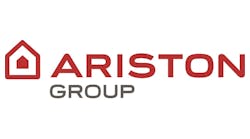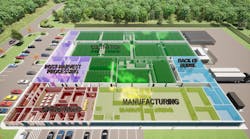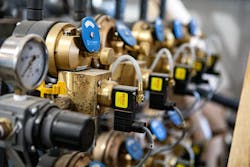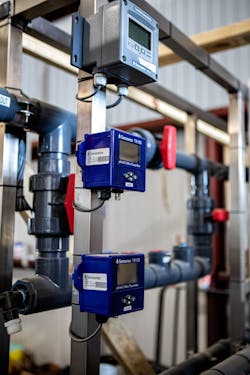With the spread of marijuana legalization across the country, the cannabis cultivation industry has seen explosive growth. According to industry researcher IBISWorld, the market size of the medical and recreational marijuana growing industry in the US has grown, on average, 34.3% per year between 2017 and 2022.
For maximum yield, consistency of end product, and reasons of security, most cannabis is cultivated via Controlled Environment Agriculture (CEA)—large, sealed buildings that foster a microclimate ideal for growth. The same system is used for most other single cycle, single harvest crops (such as ornamental flowers). Such growing facilities also typically include areas for harvesting, processing, and packaging.
The urban-gro Value Proposition
urban-gro is a design-build construction company founded in 2014 with the goal of making itself into a one-stop shop for any client that walked in the door, but with a focus on serving the (then) new cannabis industry. It developed a growth plan that worked to acquire the expertise and capacity to make that vision come true. As a part of that effort, the company found Sam Andras.
Sam Andras comes from a family of builders. His father was a GC, and he studied to become an architect, eventually opening his own company in 2001. In 2021 he was the owner of two companies, 2WR+Partners and MJ12 Design; both were acquired by urban-gro. He now works for the urban-gro as EVP of Business Development.
“My acquisition added architectural services to the team,” Andras says. Other acquisitions added MEP-FP, construction and fire protection. “For the CEA sector, we added integrated cultivation design and equipment procurement along with some post occupancy services. That whole turnkey solution was something that really excited me about the opportunity to integrate my company into that kind of vision.”
Andras says that the company works something like a restaurant. Order your appetizers, drinks, entree and desserts; build a whole meal, or pick and choose as much or as little as you want. “I think that as a company, we feel that if somebody wants a CEA facility or a fire station or whatever it is, we can deliver that turnkey much better than piecemeal,” Andras says.
A Matter of Trust
Any firm doing design-build needs to build a special rapport with their clients. To have design, pre-construction, construction, commissioning all handled by a single firm means having all your eggs in one basket. You need confidence in that firm’s ability to get the work done on time, on budget, and to your specifications. However, contracting to build a cannabis cultivation facility presents an added barrier to developing that trust.
“The [cannabis] industry, especially when I got into it back in 2012, 2013, it was like the wild, wild west,” Andras explains. “Designs were done by ‘consultants’ who were basically growers who had done garage grow. Now they were laying out entire buildings for people. The processes, and how you get from beginning to end, were not really conducive to ensuring that you're meeting the needs of a client.”
urban gro now has a proven track record of delivering for their clients, even when having to navigate a patchwork of different rules and regulations spreading across 34 states. The needs of each client are different. By meeting those need and exceeding expectations the company has been able to grow as the industry has grown, and has put itself at the forefront of emerging best practices.
Unparalleled Regulation
One key regulation concern: what are you going to do with your water? If you dehumidification system can remove 90% of the water from a building, well, where does that water go?
“There are jurisdictions that will let you dump that water, and then there's jurisdictions that won't,” Andras says. “So, if you're not allowed to dump it, do you want to then purify it and reuse it, or do you want to put it in evaporators and get rid of it? Wastewater can vary from jurisdiction to jurisdiction. And the difference with wastewater, a lot of people don't like to recycle it and try and reuse it. You really end up with a haul off or evaporators and you're hauling off the more solid materials that are still there after the evaporation process.”
And yet, for all the hassles it can cause, Andras finds designing to regulations one of the most fascinating parts of the work.
Southern Sky
Southern Sky Brands is a farm-to-patient focused medical cannabis company located in Canton, MS. The company mission is to “Unlock the healing potential found in the cannabis plant,” and to provide high quality treatment options to patients with debilitating conditions. Southern Sky Brands trusted urban-gro with the design and installation of the company’s state-of-the-art irrigation system in its 64,000 square foot cultivation and processing facility in Mississippi. It has been up and running since October of 2022.
“The reliability and performance of the system is unparalleled in the industry,” Stan Martin, P.E., Co-Founder and Director of Southern Sky Brands says. “The precision dosing system compliments our superior genetics to produce consistent, best-in-class yields. If you’re looking for a top-quality irrigation system, I would highly recommend partnering with the team at urban-gro that can turn design into reality.”
Southern Sky Brands' cultivation facility was designed with eight flower rooms with dual-tier benchings supporting 20,000+ plants, two veg rooms housing 5,400 plants, and one mother room that holds 730 plants.
To ensure optimal growth conditions, a drip irrigation system is employed throughout the facility. This system includes a robust water treatment setup that utilizes a Reverse Osmosis (RO) system. Furthermore, the facility boasts two storage tanks, with a combined capacity of 21,000 gallons, ensuring a sufficient water supply as it uses over 11,460 gallons a day.
The facility includes airlocks workers come and go through, “air showers” that remove pests before they can infiltrate the crops, as well as drying rooms and processing rooms. And everything is built to be as water- and energy-efficient as possible.
Like any other kind of agricultural facility, these buildings are using fantastic amounts of water. Since growing is done mainly with lamps not sunlight, they also consume huge amounts of electricity. As a result, extracting even the tiniest efficiencies out of the system becomes hugely over the life lifetime of the project.
“In order to survive in this industry, you have to be efficient in everything that you're doing,” Sam Andras says. Because the market is so highly competitive, “You have to have efficient mechanical systems and electrical systems in order to in turn drive operational cost down as low as possible, and in turn try and maximize your profits.”





